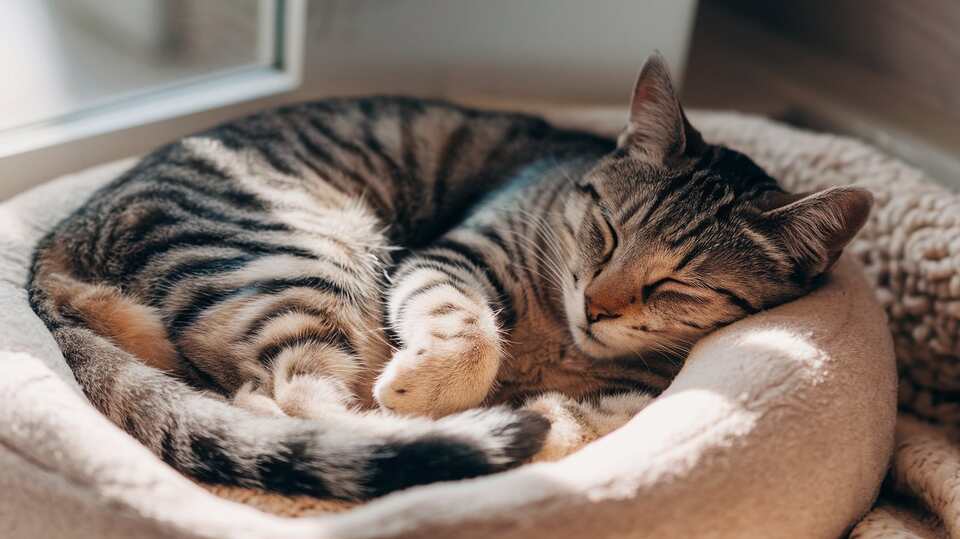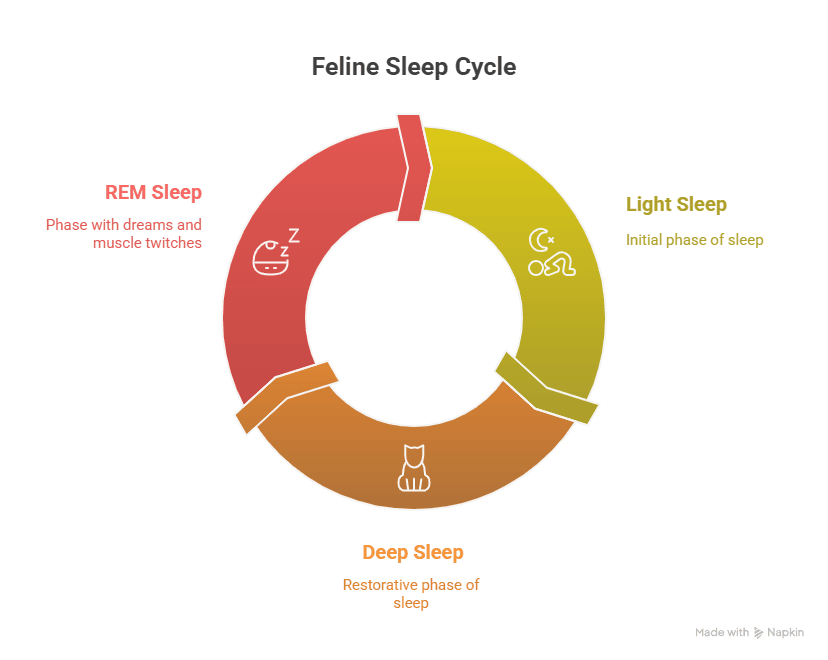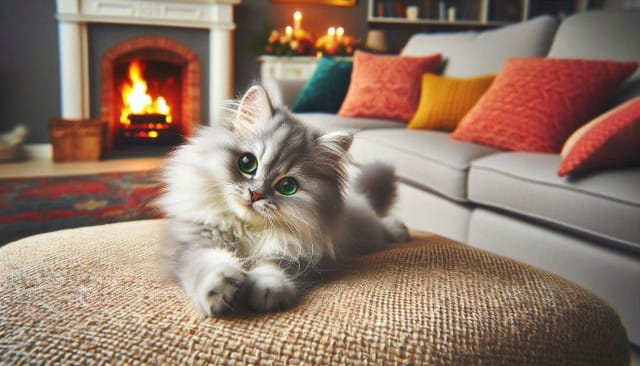
Introduction
You’re curled up on the couch, watching your cat doze peacefully. Suddenly, one of their paws jerks. Their whiskers twitch. Maybe even a soft “mew” escapes their mouth.
And you wonder:
“Why do cats twitch in their sleep?”
Is it a dream? A reflex? Or something to worry about?
In most cases, twitching during sleep is completely normal for cats, just like it is for humans and other animals. But understanding when it’s healthy versus when it might signal an issue is important for any caring pet parent.
In this article, we’ll cover:
- Why cats twitch while sleeping
- What sleep stages are responsible
- What’s considered normal, and what’s not
- The adorable theories behind what cats may dream about
What Does Sleep Twitching Look Like in Cats?
If you’ve ever observed your cat while they’re fully relaxed, you’ve likely seen some of these twitchy behaviors:
- Flicking paws or tail
- Whiskers pulsing or trembling
- Ears twitching
- Legs moving in a “running” motion
- Subtle vocalizations (chirps, squeaks, mews)
- Rapid eye movement under closed lids
Sometimes, these movements are so strong that it looks like your cat is about to wake up, but instead, they shift positions and dive deeper into sleep.
This is all part of a healthy feline sleep cycle, especially during one specific stage: REM sleep.
The Feline Sleep Cycle: More Complex Than You Think

Just like humans, cats experience multiple sleep stages throughout a typical nap:
💤 1. Light Sleep (Dozing/Resting)
Cats begin with a light sleep phase where they remain semi-alert.
- Ears may swivel at sounds
- Body stays relatively still
- Often lasts 15–30 minutes
This is the most common type of sleep cats enter throughout the day.
😴 2. Deep Sleep (Slow-Wave Sleep)
- Muscles relax
- Breathing becomes slower
- Brain activity decreases
- Helps with immune system function and recovery
This stage is restorative—but not where twitching usually happens.
🌙 3. REM Sleep (Rapid Eye Movement)
- Brain activity increases
- Dreaming occurs
- Body may twitch, paws jerk, or whiskers flutter
- Eye movement visible beneath closed lids
This is the phase where twitching is most noticeable, and where cats likely experience dreams.
Why Do Cats Twitch in REM Sleep?
During REM sleep, your cat’s brain is almost as active as it is when they’re awake. And this activity doesn’t just stay in the head, it sometimes spills over into the body.
That’s where twitching comes in.
🧠 Dreaming in Motion
Twitching is thought to be linked to dream content. Just like humans might flinch or speak in their sleep, cats may “act out” portions of their dreams with small movements.
They might be:
- Chasing a toy
- Hunting imaginary prey
- Running through the backyard
- Or even snuggling with their favorite human
The part of the brain that controls movement during REM sleep is partially suppressed, but not fully. So these twitches are like little glimpses into your cat’s dream world.
Is It Normal for Kittens to Twitch More Than Adult Cats?
Yes, and here’s why:
Kittens experience more frequent and longer REM cycles than adult cats. Their brains are still developing, and twitching during sleep is believed to play a role in:
- Muscle growth
- Nervous system development
- Sensory awareness
So if your kitten looks like they’re “play-hunting” in their sleep? Totally normal. They’re learning, literally in their dreams.
As cats age, their REM cycles become shorter, and twitching often becomes less dramatic, but it still happens regularly throughout life.
When Is Sleep Twitching a Cause for Concern?
While most twitching is harmless, there are a few signs to watch for that might indicate a health issue, especially if the twitching looks intense or unusual.
🚩 Watch for These Red Flags:
- Twitching is violent or seizure-like
- Your cat’s limbs are stiff or jerking uncontrollably
- They vocalize loudly or sound distressed
- They drool or foam at the mouth
- Their eyes roll back or they appear disoriented afterward
- They have difficulty walking or standing upon waking
In these cases, you’re likely not seeing REM twitching, but possibly a seizure or other neurological problem. If this happens even once, it’s worth a vet visit for a full evaluation.
REM Sleep Twitching vs. Seizure: Key Differences
| Feature | REM Twitching | Seizure |
| Occurs during sleep | ✅ Yes | 🚫 Not always—can happen when awake |
| Smooth, small motions | ✅ Yes | 🚫 Often jerky or rigid |
| Easy to wake up | ✅ Usually | 🚫 Often unresponsive |
| Cat wakes normally | ✅ Calm and alert | 🚫 Disoriented or scared |
| Duration | 🕐 Seconds to a few minutes | ⚠️ Can last several minutes or longer |
If you’re unsure what you witnessed, take a video and consult your vet. They can rule out epilepsy, trauma, or other underlying conditions.
Should You Wake a Twitching Cat?
The short answer? No, unless something seems wrong.
Twitching during REM sleep is:
- Natural
- Healthy
- Part of emotional and cognitive processing
Waking your cat mid-REM sleep may:
- Confuse or startle them
- Interrupt deep healing phases
- Disrupt their emotional regulation
Let your cat rest, and enjoy the show from a distance!
What Are Cats Dreaming About?
Science doesn’t allow us to peek directly into a cat’s dreams (yet), but based on REM brain activity and observed behaviors, researchers and vets believe cats likely dream about:
- Daily experiences (toys, people, food)
- Instinctual behavior (hunting, stalking, pouncing)
- Interactions with familiar humans or pets
- Territorial activities (exploring the house, chasing other animals)
Interestingly, some studies show that older cats may dream more about routine behaviors, while kittens may dream more vividly due to constant new input.
So next time you see your cat twitching in their sleep, they might be reliving that great mouse toy chase, or just dreaming of dinnertime.
How to Create the Perfect Sleep Environment for Your Cat
The quality of your cat’s sleep affects their:
- Immune function
- Mood and behavior
- Memory and learning
- Recovery from illness or stress
Here are ways to encourage deep, safe, twitch-filled slumber:
🛏️ 1. Provide Multiple Nap Zones
- Choose quiet areas with low foot traffic
- Offer soft blankets or cozy cat beds
- Elevated spaces (like window hammocks or shelves) are ideal
🎵 2. Use Calming Background Sounds
- Soft classical music or ambient cat music
- White noise to mask external sounds
- Feliway diffusers for scent-based comfort
🧸 3. Enrich Their Day, So They Sleep at Night
- Interactive play sessions (morning and evening)
- Puzzle feeders to mimic hunting
- Window perches for mental stimulation
Cats who are active and enriched during the day experience better, deeper sleep, and more adorable REM twitches!
FAQs
Why does my cat meow or chirp while twitching?
This is usually part of REM sleep and dream behavior. They might be “talking” in their dream or reacting to imaginary stimuli.
Can cats sleepwalk or act out dreams?
Cats generally do not sleepwalk. Their movements during REM are usually limited to twitches. If your cat gets up and appears confused or distressed, it could be a medical issue.
Should I be worried if my senior cat twitches more or less than before?
A change in sleep patterns (more twitching, less sleep, confusion) in older cats could signal cognitive dysfunction or other health issues. Check with your vet if you notice a shift.
My cat never seems to twitch, should I be concerned?
Not at all. Some cats twitch very subtly, or only during certain naps. The absence of twitching isn’t a cause for concern if they seem otherwise healthy and happy.
Also Read - How to Litter Train a Stray Cat: A Gentle, Step-by-Step Guide
Conclusion
So, why do cats twitch in their sleep?
In most cases, it’s simply a sign that your cat is entering deep, restorative REM sleep, and likely dreaming. These little movements, vocalizations, and flicks are not just normal, but a positive indicator of feline well-being.
Twitching is most common in kittens, healthy adults, and well-rested cats. And while it can sometimes mimic more serious medical issues, careful observation will help you tell the difference.
So the next time your cat’s paws start “running” during a nap, smile.
They’re not in distress, they’re probably off chasing dream-mice or reliving their latest feather wand victory.
Let them rest. They’ve got a whole dream world to explore. 🐾




